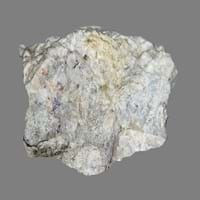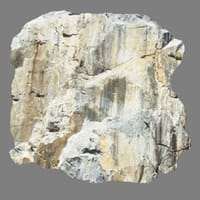Definition
Skarns are formed during regional or contact metamorphism and from a variety of metasomatic processes involving fluids of magmatic, metamorphic, and/or marine origin
Trondhjemite is a leucocratic (light-colored) intrusive igneous rock. It is a variety of tonalite in which the plagioclase is mostly in the form of oligoclase. Trondhjemites are sometimes known as plagiogranites.
Origin
USA, Australia
Tonale, Italy
Discoverer
Tornebohm
Unknown
Etymology
From an old Swedish mining term originally used to describe a type of silicate gangue or waste rock.
Not Available
Class
Metamorphic Rocks
Igneous Rocks
Sub-Class
Durable Rock, Hard Rock
Durable Rock, Hard Rock
Group
Not Applicable
Plutonic
Other Categories
Fine Grained Rock, Opaque Rock
Coarse Grained Rock, Fine Grained Rock, Medium Grained Rock, Opaque Rock
Texture
Earthy, Mud-rich, Rough
Phaneritic
Color
Black, Brown, Colourless, Green, Grey, White
Black, Brown, Light to Dark Grey, White
Durability
Durable
Durable
Scratch Resistant
Yes
Yes
Appearance
Dull
Banded and Foilated
Interior Uses
Decorative Aggregates, Entryways, Interior Decoration
Decorative Aggregates, Entryways, Flooring, Homes, Interior Decoration
Exterior Uses
As Building Stone, As Facing Stone, Garden Decoration, Paving Stone
As Building Stone, As Facing Stone, Paving Stone, Garden Decoration, Office Buildings
Other Architectural Uses
Curbing
Curbing
Construction Industry
As a Flux in the Production of Steel and Pig Iron, As a Sintering Agent in Steel Industry to process Iron Ore, As Dimension Stone, Gold and Silver production, Manufacture of Magnesium and Dolomite Refractories
As Dimension Stone, Cement Manufacture, Cobblestones, Construction Aggregate, for Road Aggregate
Medical Industry
Not Applicable
Not Yet Used
Antiquity Uses
Artifacts, Monuments, Sculpture
Artifacts, Monuments, Sculpture, Small Figurines
Commercial Uses
Creating Artwork, Gemstone, Jewelry, Metallurgical Flux, Source of Magnesia (MgO)
Cemetery Markers, Creating Artwork
Types
Endoskarns
Not Available
Features
Host Rock for Lead, Zinc and Copper Deposits
Is one of the oldest rock, Typically speckled black and white.
Archaeological Significance
Monuments
Used
Not Yet Used
Famous Monuments
Data Not Available
Not Applicable
Famous Sculptures
Data Not Available
Data Not Available
Pictographs
Not Used
Not Used
Petroglyphs
Not Used
Not Used
Formation
Due to change in environmental conditions, rocks are heated and pressurized deep inside the Earth's surface. Skarn is formed from the extreme heat caused by magma or by the intense collisions and friction of tectonic plates.
When alkali feldspar is extracted from granite, it changes to granitoid and later, it becomes trondhjemite with quartz as major mineral.
Mineral Content
Calcite, Enstatite, Epidote, Garnet, Magnetite, Pyroxene, Titanite
Albite, Amphibole, Apatite, Biotite, Feldspar, Hornblade, Ilmenite, Magnetite, Manganese Oxides, Olivine, Plagioclase, Pyroxene, Quartz, Sulfides, Titanite, Zircon
Compound Content
Au, CaO, Carbon Dioxide, Cu, Fe, MgO
NaCl, CaO, MgO, Silicon Dioxide
Types of Metamorphism
Burial Metamorphism, Cataclastic Metamorphism, Contact Metamorphism, Hydrothermal Metamorphism, Impact Metamorphism, Regional Metamorphism
Burial Metamorphism, Cataclastic Metamorphism, Contact Metamorphism, Impact Metamorphism, Regional Metamorphism
Types of Weathering
Not Applicable
Biological Weathering, Chemical Weathering, Mechanical Weathering
Types of Erosion
Not Applicable
Chemical Erosion, Coastal Erosion, Glacier Erosion, Sea Erosion, Water Erosion, Wind Erosion
Grain Size
Fine Grained
Medium to Fine Coarse Grained
Fracture
Irregular
Conchoidal
Streak
Light to dark brown
Bluish Black
Porosity
Less Porous
Very Less Porous
Luster
Waxy and Dull
Subvitreous to Dull
Cleavage
Slaty
Not Available
Specific Gravity
2.86
2.86-3
Transparency
Opaque
Opaque
Density
2.8-2.9 g/cm3
2.73 g/cm3
Resistance
Heat Resistant
Heat Resistant, Pressure Resistant, Wear Resistant
Deposits in Eastern Continents
Asia
China, India, Russia, Saudi Arabia, South Korea, Sri Lanka
Not Yet Found
Africa
South Africa, Western Africa
Egypt
Europe
United Kingdom
Finland, Germany, Italy, Romania, Sweden, Turkey
Others
Not Yet Found
Not Yet Found
Deposits in Western Continents
South America
Brazil, Colombia, Paraguay
Argentina, Bolivia, Chile, Colombia, Ecuador, Peru
Deposits in Oceania Continent
Australia
Central Australia, Western Australia
New Zealand, South Australia, Western Australia
All about Skarn and Trondhjemite Properties
Know all about Skarn and Trondhjemite properties here. All properties of rocks are important as they define the type of rock and its application. Skarn belongs to Metamorphic Rocks while Trondhjemite belongs to Igneous Rocks.Texture of Skarn is Earthy, Mud-rich, Rough whereas that of Trondhjemite is Phaneritic. Skarn appears Dull and Trondhjemite appears Banded and Foilated. The luster of Skarn is waxy and dull while that of Trondhjemite is subvitreous to dull. Skarn is available in black, brown, colourless, green, grey, white colors whereas Trondhjemite is available in black, brown, light to dark grey, white colors. The commercial uses of Skarn are creating artwork, gemstone, jewelry, metallurgical flux, source of magnesia (mgo) and that of Trondhjemite are cemetery markers, creating artwork.










